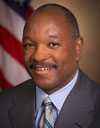Michael A. Battle
For the theologian and academic see Michael J. Battle.

Michael A. Battle was the Director of the Executive Office for United States Attorneys (EOUSA) at the United States Department of Justice until he resigned, effective March 16, 2007. He was the person who informed seven United States Attorneys on December 7, 2006 that they were being dismissed (see Dismissal of U.S. attorneys controversy).
Early career
| Dismissal of U.S. attorneys controversy () |
| Articles |
|---|
|
| G. W. Bush administration officials involved |
|
| Involved administration officials who resigned |
|
| U.S. Senate Committee on the Judiciary 110th Congress |
|
| U.S. House Committee on the Judiciary 110th Congress |
|
Battle is a 1977 graduate of Ithaca College [1] and a 1981 graduate of University at Buffalo Law School.[2] From 1985 to 1992, he was an Assistant U.S. Attorney in Buffalo, New York, where he served in the General Criminal Division, the Civil Division, and on the Organized Crime and Drug Enforcement Task Force. Following his admission to the New York bar, he worked as a staff attorney with the Legal Aid Society Civil Division. In 1992, he helped to establish the Rochester and Buffalo Federal Public Defender's Offices, where he served until 1995. In June 1996, he was appointed by Governor George Pataki to serve as a judge on the Erie County (New York) Family Court and was elected the following November to a full 10-year term. From 1995 to 1996, he served as Assistant in Charge of the Buffalo office of the New York State Attorney General.
From January 2002 to May 2005 Battle served as U.S. Attorney for the Western District of New York.
Involvement in the internment of Benamar Benatta
During his time as U.S. Attorney for the Western District of New York, he was responsible for the case of Benamar Benatta who was held without trial for five years following his forcible rendition from Canada on September the 12th 2001. The FBI concluded Benatta was innocent that November, however according to federal Magistrate Judge H. Kenneth Schroeder Jr, Battle then conspired with the FBI and immigration agents in a "sham" to make it appear that Benatta was being held for immigration violations.[3]
In October 2003, when Battle announced he was dropping charges, a Buffalo reporter asked whether he planned to apologize to Benatta, Battle responded "I'm not going to address that.[4]" Benamar Benatta was finally released in 2006 after 5 years, despite being cleared in November 2001.
According to Judge Schroeder who was assigned to investigate Benatta's treatment, "Prosecutors trampled on legal deadlines intended to protect his constitutional rights and later offered explanations for their manoeuvres that bordered on ridiculousness," he found that the government compounded its mistakes by failing to act once it was clear that Benatta was not an accomplice to terrorists. A United Nations working group later described the treatment of Benatta as torture.[5] Battle was then promoted by the White House. The Los Angeles Times reported that Benatta had been held for a total of 1,780 days, which gave him the distinction of being held on jail without charge longer than any other suspect in the US.[6]
Executive Office for the United States Attorneys
Battle began his service as Director of the Executive Office for United States Attorneys (EOUSA) at the United States Department of Justice on June 6, 2005. He was involved the Dismissal of U.S. attorneys controversy, as he was the Justice Department official who, on December 7, 2006, informed seven US Attorneys that they were being dismissed.[7] Just as publicity was heating up, and Congress began issuing subpoenas, he resigned on March 5, 2007, effective March 16.[8][9]
References
- ↑ "...And for the People, Michael Battle". Ithaca College Quarterly.
- ↑ "New Job for Michael Battle '81". University of Buffalo Law School.
- ↑ Michael Battle's involvement in the internment of Benamar Benatta as detailed in the Washington Post
- ↑ refused to consider apology per Washington Post
- ↑ UN working group described Benatta's treatment as torture in Benamar Benatta v. United States of America, Working Group on Arbitrary Detention, U.N. Doc. E/CN.4/2005/6/Add.1 at 67 (2004).
- ↑ Post-9/11 Detainee Returns to His Life, Los Angeles Times, August 18, 2006
- ↑ Hartley, Allegra (2007-03-21). "Timeline: How the U.S. Attorneys Were Fired". US News & World Report. Retrieved 2007-03-26.
- ↑ David Johnston (March 6, 2007). "Messenger in Prosecutors' Firings Quits". New York Times.
- ↑ http://www.nytimes.com/2007/03/06/washington/06inquire.html?ex=1330837200&en=682ea9a6d2069de0&ei=5088&partner=rssnyt&emc=rss&_r=0
He was also credited with the arrest and prosecution of the Lackawanna Six Terror Cell during the time of September 11, 2001
External links
| Find more about Michael A. Battle at Wikipedia's sister projects | |
| |
Definitions and translations from Wiktionary |
| |
Media from Commons |
| |
Quotations from Wikiquote |
| |
Source texts from Wikisource |
| |
Textbooks from Wikibooks |
| |
Learning resources from Wikiversity |